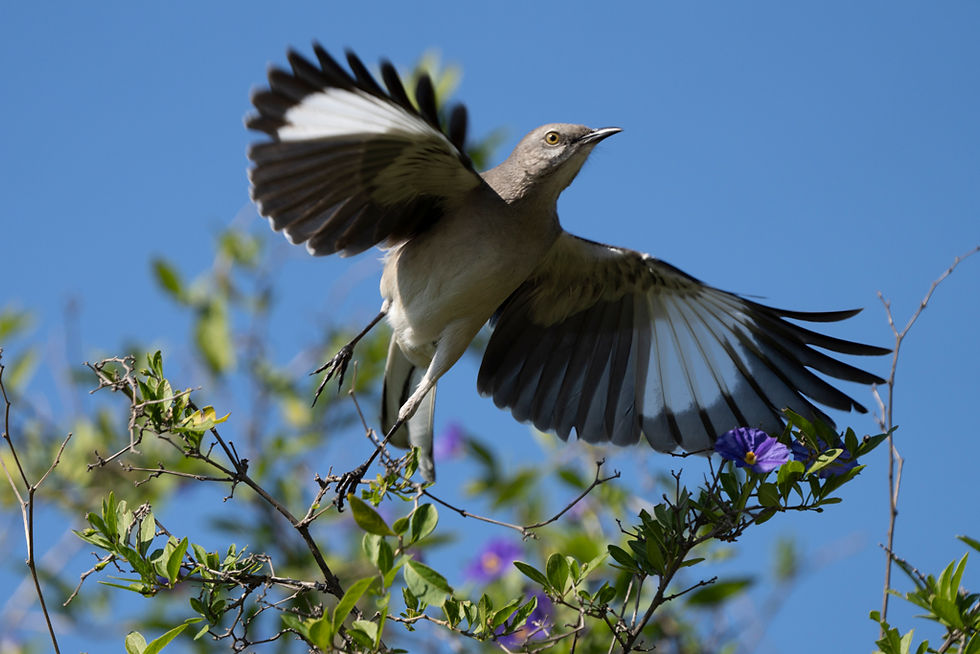Birds are Amazing: The Mockingbird
- Dale Lauterback

- Aug 22
- 3 min read

Mockingbirds: The Chihuahuas of the Sky
Height: 8.5 - 10 in.
Wingspan: 13-15 in.
Weight: 1 - 2 oz
Lifespan: up to 20 years
Few birds capture the imagination quite like the mockingbird. With its silvery-gray plumage and unassuming appearance, the Northern Mockingbird (Mimus polyglottos) might seem modest at first glance, but its vocal abilities are anything but. Known for its remarkable capacity to mimic other birds, animals, and even mechanical sounds, the mockingbird is a true virtuoso of the avian world. Found across much of North America, this intelligent and charismatic bird has become a symbol of creativity, adaptability, and resilience.
Appearance and Identification
The Northern Mockingbird is a medium-sized songbird with a slender body, long tail, and relatively long legs. Its feathers are mostly gray above and whitish below, with distinctive white patches on the wings that flash dramatically in flight. Though not particularly colorful, its animated behavior and constant singing make it a standout presence in yards, parks, and open woodlands.

A Voice Like No Other
The mockingbird’s most extraordinary trait is its vocal range. A single male can learn and sing up to 200 different songs throughout its lifetime. What makes them especially fascinating is their talent for mimicry—they can imitate the calls of other birds, insects, frogs, and even human-made noises like car alarms or ringtones.
Males sing most frequently during the breeding season, both to attract mates and to establish territory. Their songs can last for hours, and they often sing both day and night, especially during a full moon or in urban areas where artificial light keeps them active. It's not unusual to hear a lone mockingbird crooning at midnight, stringing together a surreal medley of chirps, whistles, and buzzes.
Habitat and Range
Mockingbirds are highly adaptable and thrive in a wide variety of habitats, from forest edges and scrublands to suburban neighborhoods and city parks. Their range covers much of the United States, Mexico, and parts of Central America. Once mostly confined to the southern U.S., the Northern Mockingbird has gradually expanded its range northward, thanks to its ability to adapt to human-altered landscapes.
Behavior and Intelligence
These birds are not just talented singers—they're also fiercely territorial. Mockingbirds will aggressively defend their nests and territories against much larger animals, including humans. They’ve been known to dive-bomb cats, dogs, and even people who venture too close to their nesting sites.

If you've ever walked past a tree and suddenly felt like you were being dive-bombed by an angry little bird, chances are, you've met the mockingbird—nature’s version of a Chihuahua with wings. These feisty feathered defenders pack an outsized attitude in a small body, and when it comes to guarding their turf, they don’t back down, no matter the size of the intruder.
Like the famously scrappy Chihuahua, mockingbirds have zero concept of their own size. They’ll boldly go after hawks, cats, dogs, squirrels, and even unsuspecting humans who wander too close to their nests. Their confidence is almost comical—these birds don’t just chirp warnings from a distance; they chase, swoop, and squawk like airborne watchdogs on a mission.
Mockingbirds are fiercely territorial, especially during breeding season. Both males and females participate in defending their nest and the surrounding area with relentless energy. Their dive attacks are more than just for show—they’re a warning with wings, and they often succeed in driving away much larger animals.

What makes mockingbirds particularly amusing (and Chihuahua-like) is their audacity. It’s not unusual to see one harassing a red-tailed hawk, a predator many times its size, without a hint of hesitation. They’ll even perch nearby afterward, chirping loudly as if to declare victory.
Despite their tiny frame, mockingbirds are tough, persistent, and unapologetically loud. Just like Chihuahuas, they’re small but mighty, packing a punch of personality that’s hard to ignore.
The photographs contained in this website may not be reproduced without the express consent of Shutter Bison.










Comments